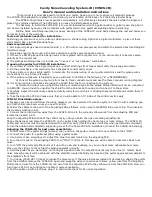
______________________________________________________________________
Co
Brite
User Manual
28
7
Remote Control
This device operates using SCPI standard style commands which are ASCII based and allow
easy communication and interpretation with the instrument. Refer to chapter “Board and
Connector description” on how to establish communication to the ports available at the
instrument. More detailed information on SCPI syntax can be found here:
http://www.ivifoundation.org/docs/SCPI-99.PDF
7.1
Operating multiple Interface Ports
This unit supports parallel usage of all remote-control ports available. Note that responses to
commands issued are only returned to the according interface from where the command was
issued.
Commands are generally executed in order of time wise arrival to the controller and buffered
into an Event queue. If a stack overflow occurs, an error is issued.
Note that there is no control exclusivity for a specific interface or user. Thus, parallel commands
issued by different instances will be might lead to inconsistencies. It is therefore recommended
to poll current parameter status to ensure integrity of set vs. actual parameters and query the
operation complete register (“
*opc?
”) to make sure all previous commands have been
executed or applied to the laser control. Note that it is
recommend to use the query “
busy?
” to
determine if a laser port is still tuning as the
“
*opc?
” query will only tell if the corresponding
change of configuration has been triggered but might not be completed.
7.2
Query Connection types
Connections to remote control the unit via SCPI can be made either by using telnet protocol on
port 2000 or HTTP queries. While for performance reasons, telnet-based access should be
preferred, HTTP based access can be used in installations where Port 2000 is blocked by
Network firewalls or routers since HTTP uses Port 80 which is open in most networks.
7.2.1
Telnet based
Connections made with the device can be session based by a raw terminal connection (see
4.2.3) using Port 2000 for Ethernet or a COM Port session (4.3.1.3).
Connections through HTTP Service (Port 80). In this case, the SCPI command is encapsulated
in the following http request:
http://<CoBrite Ip>/scpi/<SCPI-Command>
7.2.2
HTTP based
Example:
http://cobrite.local/scpi/*idn?
queries the identification string of the unit.
For a quick test, simply copy this query into the browser address field.
The ASCII encoded response is identical to the session-based response.
<wsp> characters defined in the SCPI definitions are to be replaced with ASCII string “%20” per
HTML code standard requirements
. No termination character “;” or <CR> is needed for HTTP
based access.
Multiple commands can be sent within a single query by means of separation via the termination
character “;”
Example:
http://cobrite.local/scpi/*idn?;lay?
Note that this connection type is not session based like the terminal connection. So, each query
sent will establish a new session which is terminated after response the query response is
given. Consequently, commands requiring elevated user rights will require to send the password
with the actual query in the same request.
Example:
http://cobrite.local/scpi/pass%20IDP;pass?
will send the password “IDP” to the unit to elevate














































